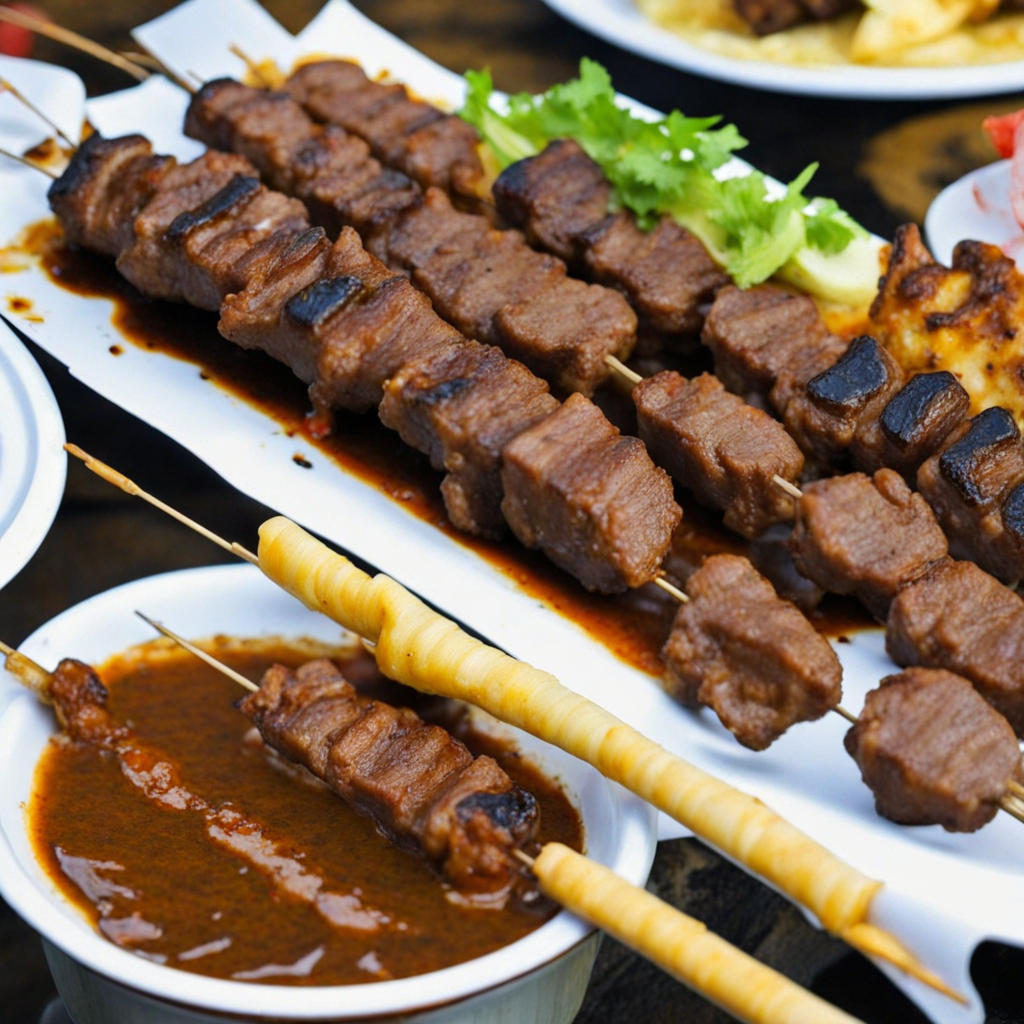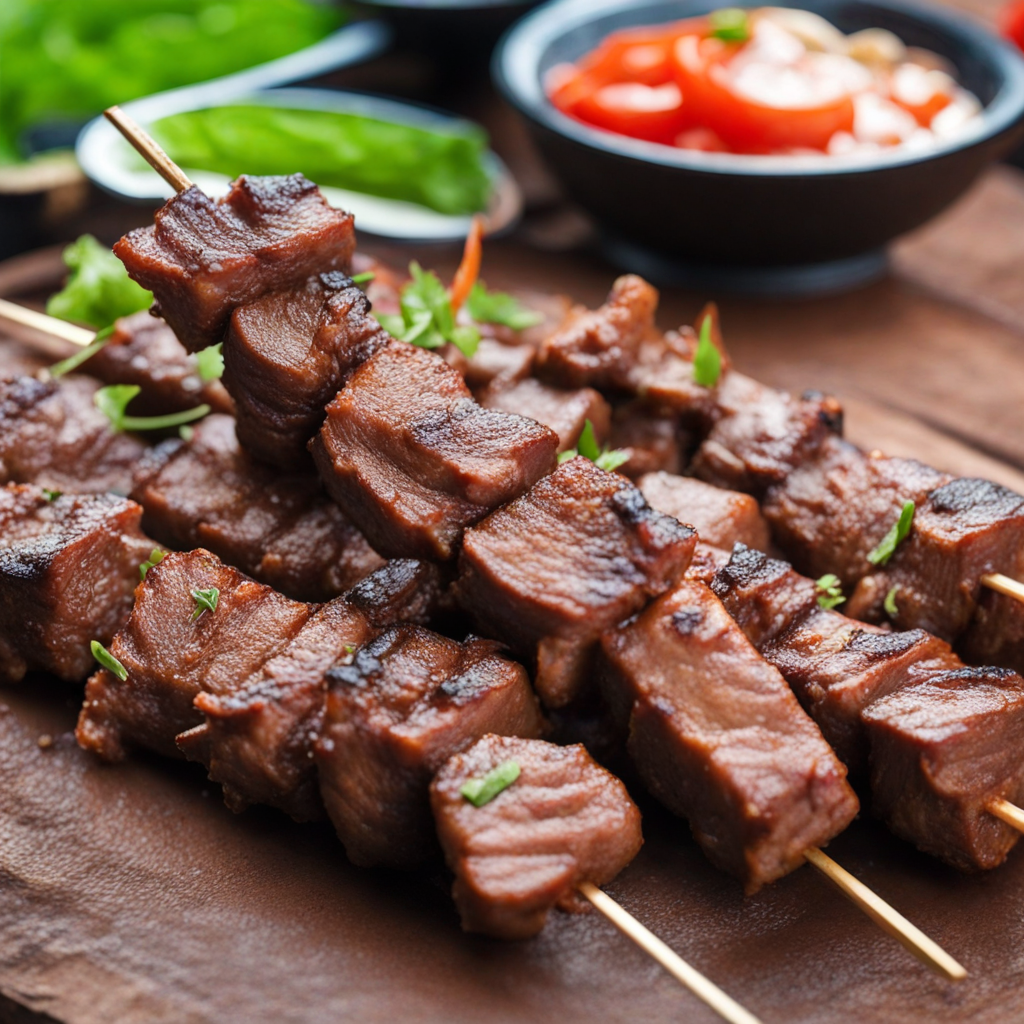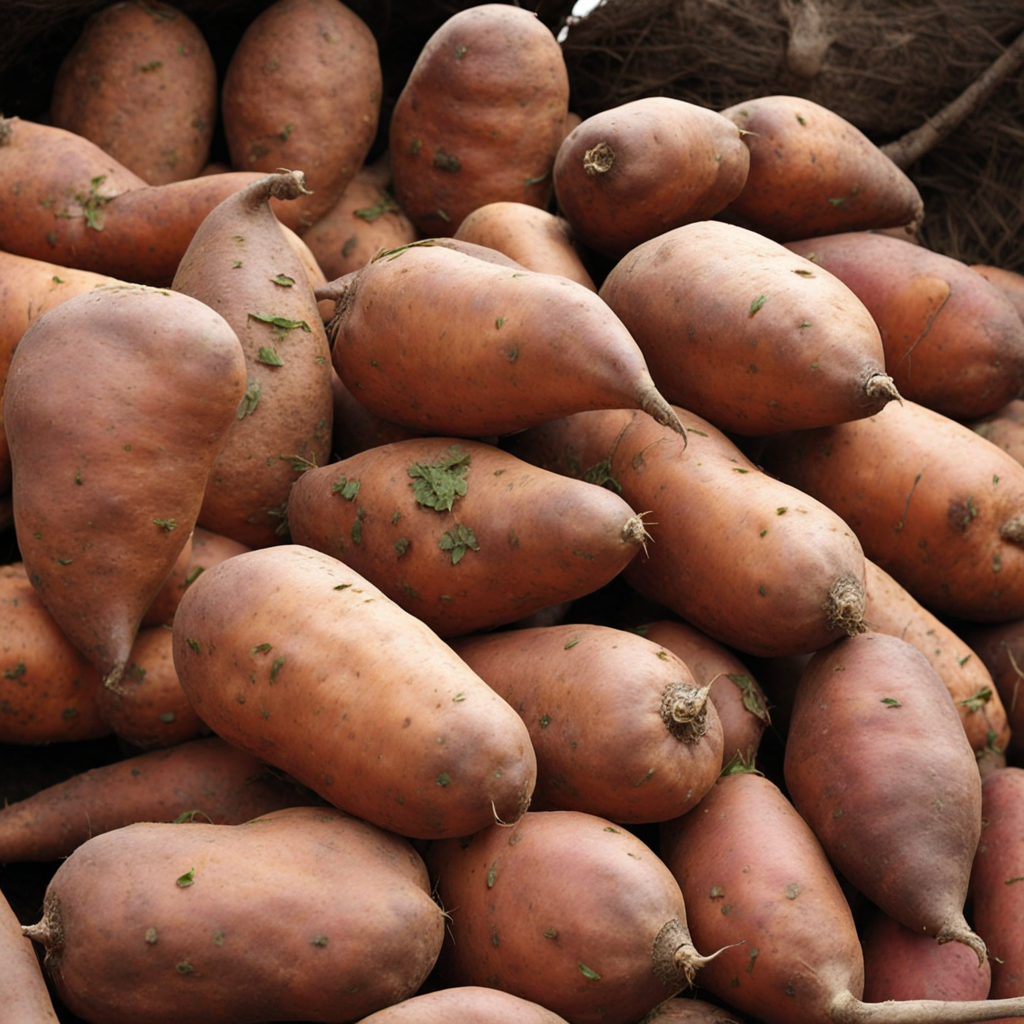Beef Brochettes
Beef Brochettes, a popular dish in Burundi, offer a delightful experience for those looking to explore new flavors. This savory delight consists of marinated beef skewers, typically grilled to perfection over an open flame. The marinade, often a blend of local spices, garlic, and sometimes a hint of citrus, infuses the meat with a rich and aromatic depth. The charred exterior from the grilling adds a satisfying smokiness that contrasts beautifully with the tender, juicy interior of the beef, making each bite a burst of flavor. Served alongside traditional accompaniments, such as grilled vegetables or a fresh salad, Beef Brochettes are not just a meal but a celebration of Burundi's culinary traditions. The vibrant colors of the vegetables add to the visual appeal, while the fresh herbs used in the preparation enhance the dish's overall freshness. Often enjoyed during communal gatherings or festive occasions, these skewers embody the spirit of sharing and togetherness that is integral to Burundian culture. The experience of savoring Beef Brochettes is further elevated by the dipping sauces that often accompany the dish. These sauces, which can range from spicy chili to a tangy peanut sauce, add another layer of complexity and allow you to customize each bite to your taste preferences. As you indulge in this hearty and flavorful dish, you’ll find that Beef Brochettes encapsulate not only the rich culinary heritage of Burundi but also the warmth and hospitality of its people.
How It Became This Dish
The History of Brochettes in Burundi #### Origins of Brochettes Brochettes, a delightful culinary staple in Burundi, are skewered meat dishes that have garnered popularity across various cultures, but in Burundi, they hold a special place in the heart of the nation. The origins of brochettes can be traced back to traditional cooking methods in the region, where communal gatherings and feasts often featured grilled meats as central elements of the celebration. Historically, Burundi's cuisine has been influenced by its geography and the agricultural practices of its people. Nestled in East Africa, Burundi boasts a rich biodiversity, with its lush hills providing ample opportunities for livestock farming. The Tutsi, Hutu, and Twa ethnic groups, which comprise the majority of the Burundian population, have all contributed to the evolution of local cuisine, with meat being a significant component of their diets. The concept of skewering meat likely originated as a practical way to cook over open flames, maximizing flavor while allowing for efficient cooking. As early Burundians learned the art of grilling, brochettes became synonymous with social gatherings, where families and friends would come together to share meals, stories, and laughter. #### Cultural Significance In Burundian culture, brochettes are more than just a meal; they represent community, hospitality, and tradition. The act of grilling meat over an open flame is often a communal affair, with family members and friends gathering to prepare and cook brochettes together. This culinary ritual fosters a sense of unity, reinforcing bonds within families and communities while celebrating the act of sharing food. Brochettes are particularly prominent during festivals, weddings, and other significant life events. The dish is often served alongside traditional accompaniments, such as ugali (a maize porridge) or plantains, highlighting the importance of food in Burundian social customs. The preparation and sharing of brochettes during these occasions symbolize abundance and joy, reinforcing the role of food in expressing cultural identity. Moreover, brochettes have evolved into a beloved street food in Burundi, with vendors offering their versions in bustling markets and along busy streets. This accessibility has allowed brochettes to transcend social classes, making them a unifying dish that can be enjoyed by everyone, from local families to tourists eager to experience Burundian flavors. #### Development Over Time The development of brochettes in Burundi reflects broader changes in the country's social and economic landscape. In the past, brochettes were primarily made from beef, a reflection of the pastoral lifestyle of many Burundians. Cattle have long been a symbol of wealth and status in Burundian society, and beef skewers were often reserved for special occasions. As Burundi's population grew and urbanization increased, the availability of different meats contributed to the evolution of brochettes. Today, chicken and goat meat are also popular choices for skewering, allowing for a diverse array of flavors and textures. The advent of spice trade and the influence of neighboring countries introduced new marinades and seasoning techniques, enriching the flavor profiles of brochettes and elevating them to new culinary heights. With the rise of globalization and increased exposure to international cuisines, Burundian brochettes have also been adapted to incorporate elements from other cooking traditions. Some vendors now offer fusion brochettes that combine local ingredients with global flavors, such as spicy marinades inspired by Asian cooking or Western-style barbecuing techniques. This evolution speaks to the adaptability of Burundian cuisine and its ability to embrace new influences while remaining rooted in tradition. In recent years, the focus on sustainability and local sourcing has also impacted the way brochettes are prepared. With a growing awareness of environmental issues, many chefs and home cooks are prioritizing the use of locally sourced meats and organic vegetables, reducing their carbon footprint while supporting local farmers. This trend has not only enhanced the flavor of brochettes but has also reinforced the connection between food, community, and the environment. #### Brochettes in Modern Burundi Today, brochettes are a celebrated part of Burundian culinary heritage, served in homes, restaurants, and food stalls alike. They symbolize the resilience and creativity of a nation that has experienced significant challenges, yet continues to honor its traditions through food. The popularity of brochettes has also contributed to a burgeoning street food culture in Burundi, with food festivals and markets showcasing the diverse flavors of the country. As tourism has grown in Burundi, so too has the interest in its culinary offerings. Visitors are increasingly drawn to the country's rich cultural heritage and the authenticity of its street food. Brochettes have emerged as a must-try dish for tourists, providing a delicious gateway to understanding Burundian culture and hospitality. Moreover, the global interest in ethnic and street food has spurred a revival of traditional cooking methods, inspiring a new generation of chefs to explore and celebrate their culinary roots. Burundian cuisine, particularly dishes like brochettes, is gaining recognition beyond its borders, showcasing the delicious flavors and vibrant culture of this small East African nation. #### Conclusion The history of brochettes in Burundi is a testament to the enduring nature of culinary traditions and their power to unite communities. From its humble beginnings as a practical method of cooking to its current status as a beloved dish enjoyed by many, brochettes encapsulate the essence of Burundian culture. They serve as a reminder of the importance of community, the richness of local ingredients, and the joy of sharing a meal with loved ones. As Burundi continues to evolve, so too will its culinary landscape. Yet, the spirit of brochettes—rooted in tradition, community, and flavor—will undoubtedly remain a cherished aspect of Burundian identity for generations to come.
You may like
Discover local flavors from Burundi







